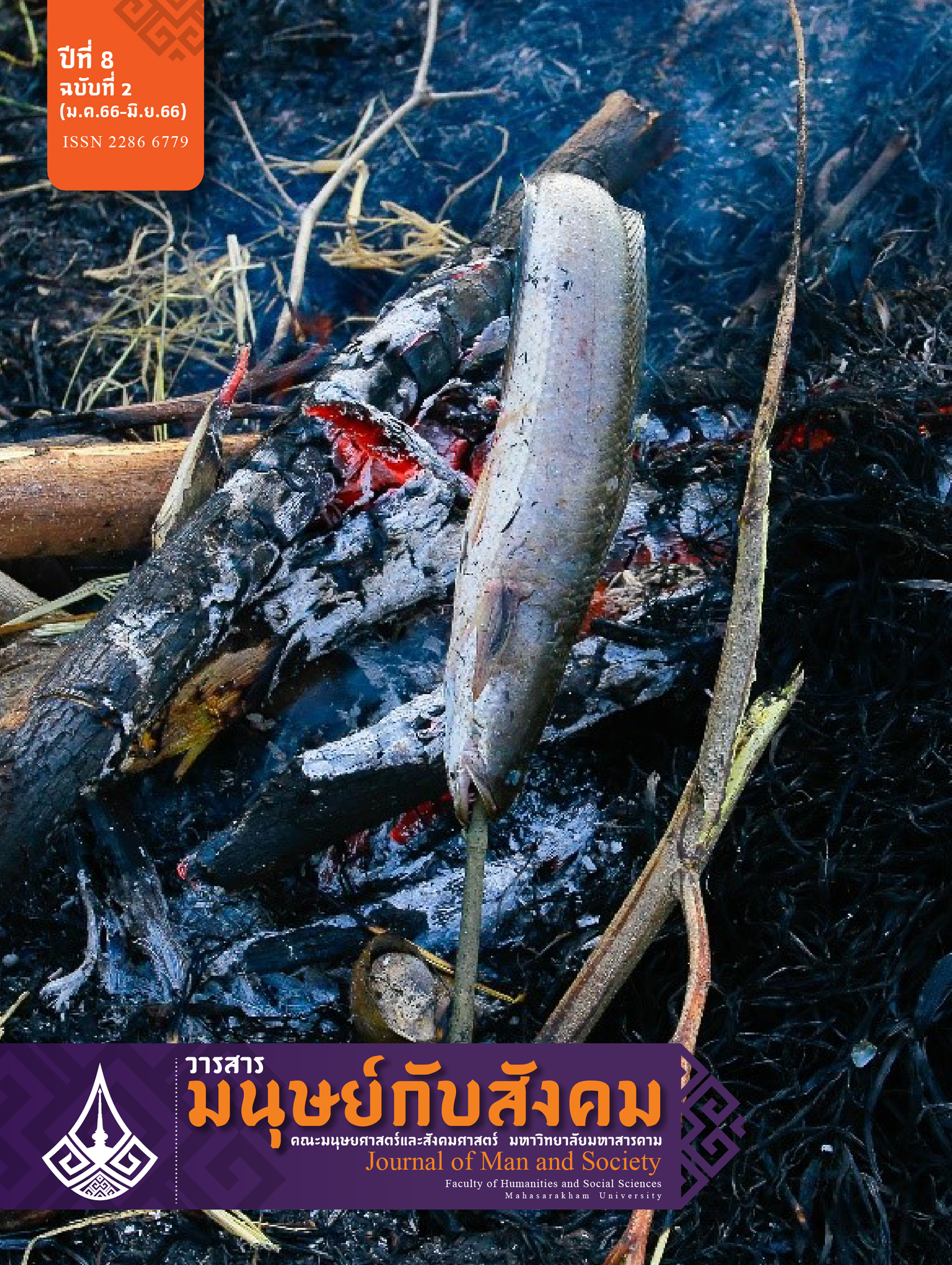Development of Burmese Buddhist Literature in Burma and Worldview Adjustment of the Burmese Elites during the Konbaung Dynasty
Main Article Content
Abstract
This article illustrates the development of Burmese Buddhist literature since the 12th century. In its early period, Burmese Buddhist literature was mainly influenced by the Theravada Buddhist tradition in Sri Lanka. Around the 17th-18th centuries, the Burmese Buddhist literature had some prosodic change, and few Burmese literati appeared to compose texts related to the corporeal and material worlds. However, in the 19th century, when the Konbaung Dynasty was defeated in the Anglo-Burmese Wars, there came in this period the important determinant factor, such as printing technology, which immensely influenced the knowledge transformation and worldview adjustment of the Burmese elites, especially those elites of the Chindwin basin, which had a close connection with influential monks during the Konbuang Dynasty.
Article Details

This work is licensed under a Creative Commons Attribution-NonCommercial-NoDerivatives 4.0 International License.
เนื้อหาและข้อมูลที่ตีพิมพ์ลงในวารสารมนุษย์กับสังคม ถือเป็นข้อคิดเห็นและความรับผิดชอบโดยตรงของผู้เขียนซึ่งกองบรรณาธิการวารสารไม่จำเป็นต้องเห็นด้วยหรือร่วมรับผิดชอบใดๆ
บทความ ข้อมูล เนื้อหา รูปภาพ ฯลฯ ที่ได้รับการตีพิมพ์ในวารสารมนุษย์กับสังคม ถือเป็นลิขสิทธิ์ของวารสาร หากบุคคลหรือหน่วยงานใดต้องการนำทั้งหมดหรือส่วนหนึ่งส่วนใดไปเผยแพร่ต่อต้องอ้างอิงวาสาร
References
คณะสงฆ์หนเหนือ. (2552). ปัญญาสชาดก (พิมพ์ครั้งที่ 3). กรุงเทพฯ: ศิลปาบรรณาคาร.
ชาญวิทย์ เกษตรศิริ. (2533). พม่า: ขบวนการนักศึกษากับประวัติศาสตร์อันระทึกใจ. กรุงเทพฯ: ประพันธ์สาส์น.
ธรรมเจดีย์. (1925). จารึกกัลยาณี เรื่องพงศาวดารสมณวงศ์นิกายฝ่ายใต้: คำจารึกภาษามคธทั้งคำแปลเปนภาษาไทยแลภาษาอังกฤษ. กรุงเทพฯ: โสภณพิพรรฒธนากร.
ธิดา สาระยา. (2554). มัณฑะเล นครราชธานี ศูนย์กลางแห่งจักรวาล (พิมพ์ครั้งที่ 2 ปรับปรุงใหม่). กรุงเทพฯ: เมืองโบราณ.
นิธิ เอียวศรีวงศ์. (2562). ว่างแผ่นดิน ประวัติศาสตร์เปรียบเทียบ “กรุงแตก” ในสามราชอาณาจักร. กรุงเทพฯ: มูลนิธิโตโยต้าประเทศไทย.
เมียนต์, นินิ. (2543). Burma’s struggle against British imperialism, 1885-1895 [พม่ากับการต่อต้านจักรวรรดินิยมอังกฤษ ค.ศ. 1885-1895]. มูลนิธิโครงการตำราสังคมศาสตร์และมนุษยศาสตร์.
นิยะดา เหล่าสุนทร. (2538). ปัญญาสชาดก: ประวัติและความสำคัญที่มีต่อวรรณกรรมร้อยกรองของไทย. กรุงเทพฯ: ม.ป.พ.
ปัญญาสามี. (2506). ศาสนวงศ์หรือประวัติศาสนา. รุ่งเรืองธรรม.
เลดีสย่าดอ, มหาเถระ. (2514). วิปัสสนาทีปนี: การแสดงเหตุอย่างพิสดารแห่งภาวนามยปัญญา. ม.ป.พ.
เลดีสย่าดอ, มหาเถระ. (2552). อภิธัมมัตถสังคหะและปรมัตถทีปนี (พิมพ์ครั้งที่ 3). ประยูรสาส์นไทย.
สุภัทรดิศ ดิศสกุล, ม.จ., สันติ เล็กสุขุม และสุจิตต์ วงษ์เทศ. (2549). เที่ยวดงเจดีย์ ที่พม่าประเทศ ทางประวัติศาสตร์ศิลปะและวัฒนธรรม (พิมพ์ครั้งที่ 2). กรุงเทพฯ: มติชน.
อนุมานราชธน, พระยา. (2512). เล่าเรื่องในไตรภูมิของเสฐียรโกเศศ. ม.ป.ท.: ม.ป.พ.
ทินอ่อง, หม่อง. (2551). A History of Burma [ประวัติศาสตร์พม่า] (พิมพ์ครั้งที่ 3). มูลนิธิโตโยต้าประเทศไทย.
อาภาโสม ฉายแสงจันทร์. (2541). การศึกษาเชิงวิเคราะห์ มธุรสวาหินี ลังกาทีป. [วิทยานิพนธ์ปริญญามหาบัณฑิต, มหาวิทยาลัยศิลปากร]. Silpakorn University Repository. https://sure.su.ac.th/xmlui/handle/
/1716?attempt=2&
Bode, M. H. (1966). The Pali Literature of Burma. London: Royal Asiatic Society.
Brereton, B. P. (1995). Thai Tellings of Phra Malai: Texts and Rituals Concernind a Popular Buddhist Saint. Tempe, Arizona: Program for South and Southeast Asian Studies.
Cady, J. F. (1960). A Historty of Modern Burma. (2nd Edition). New York: University of Cornell Press.
Charney, M. (2006). Powerful Learning Buddhist Literati and the Throne in Burma’s Last Dynasty, 1752–1885. Michigan: Centers for South and Southeast Asian Studies, University of Michigan.
Houtman, G. (1990). Traditions of Buddhist practice in Burma [Ph.D., School of Oriental and African Studies, London University]. ResearchGate. https://www.researchgate.net/publication/340488328_Traditions_of_Buddhist_practice_in_Burma.
Norman, K. R. (1983). Pali Literature. Wiesbaden: Otto Harrassowitz.
Sarkisyanz, E. (1965). Buddhist Backgrounds of the Burmese Revolution. Germany: Springer-Science+Business Media.
Smith, D. E. (1965). Religion and Politics in Burma. Princeton: University of Princeton Press.
Taylor, R. H. (1987). The State in Burma. Honolulu: University of Hawaii Press.
Than, T. (1956). History of Buddhism in Burma A.D. 1000-1300 [Doctoral Dissertation, University of London]. The Online Burma/Myanmar Library. https://www.burmalibrary.org/en/history-of-buddhism-inburma-ad-1000-1300.
Maung Khin Hmin danu hpju. (2004). [ท่องไปตามหมุดหมายวรรณกรรม]. Yangon: ein me’ u sa paei.
Pan Hmwei, Maung. (2010). [Mjama nain ngan jahan da hnin jahan htu mja pa hta ma twe]. Yangon: Myanmar to win mjou ma sa pei.
Sa pei bei’ hman poun hnei’ tai’. (1955). [Myanmar Encyclopedia Vol. 2]. Yangon: Sa pei bei’ hman poun hnei’ tai’.
Sa pei bei’ hman poun hnei’ tai’. (1970). [Myanmar Encyclopedia Vol. 11]. Yangon: Sa pei bei’ hman poun hnei’ tai’.
Sa pei bei’ hman poun hnei’ tai’ . (1971). [Myanmar Encyclopedia Vol. 12]. Yangon: Sa pei bei’ hman poun hnei’ tai’.
Sa pei bei’ hman poun hnei’ tai’. (1975). [Myanmar Encyclopedia Vol. 4]. Yangon: Sa pei bei’ hman poun hnei’ tai’.

